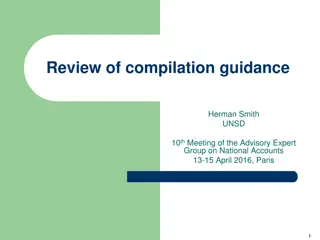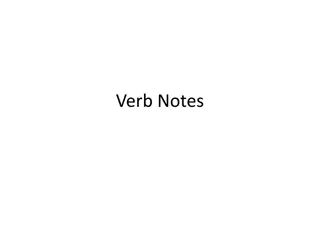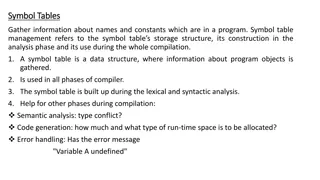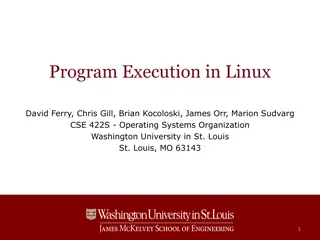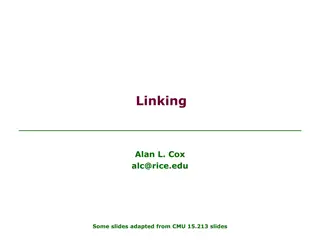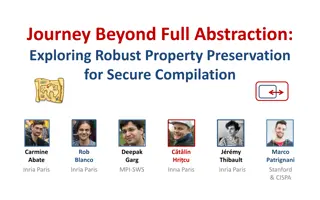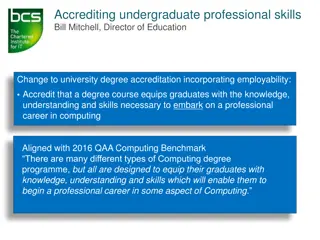Evolution of Separate Compilation and Linking in Computing
Separating compilation and linking processes has been crucial for code reusability and program efficiency in computing history. From the early days of manually recalculating addresses to modern linkers and library routines, the evolution has revolutionized how programs are developed and executed on different computing platforms.
Download Presentation

Please find below an Image/Link to download the presentation.
The content on the website is provided AS IS for your information and personal use only. It may not be sold, licensed, or shared on other websites without obtaining consent from the author. Download presentation by click this link. If you encounter any issues during the download, it is possible that the publisher has removed the file from their server.
E N D
Presentation Transcript
Lecture 7 Separate compilation Computing platforms Novosibirsk State University University of Hertfordshire D. Irtegov, A.Shafarenko 2018
The problem In previous lecture we learned how to create subroutines. There are many kinds of subroutines good for reuse, like multiplication, division, string operations, etc How to actually do the reusing?
Solutions: #include statement Not present in CdM-8 assembler Slow on big programs Not an issue for CdM-8 But bad for real computers label name conflicts ( name space pollution ) What happens if several modules have conlicting asect directives?
Separate compilation and linking Historically, was invented independently and slightly before of assembler Now, assemblers and linkers are considered a tightly-coupled elements of toolchain By default, assembler produces not a final memory image, but some intermediate format, known as object file Linker collects several object files and links them into final memory image (executable file)
History of linkers and library routines Code reuse was introduced by Grace Hopper in 1944 when programming a Harvard Mark I computer (aka IBM ASCC) Mark I was a sequential (not von Neumann) computer Sequential computer program contains no addresses Only way to implement a loop is to unroll it (like we did with multiplication routine in prev. lecture) No conditional statements nor while loops You could insert a subroutine in any point of the program, provided that it matches a calling convention
Subroutines on von Neumann computers On von Neumann computer, programs contain addresses (in assembler they are label references) To relocate program in memory, we must recalculate these addresses When programming early von Neumann computers (EDVAC, UNIVAC) people tried to recalculate addresses manually, but this took time and produced many errors Then, Grace Hopper come with the idea of linker or link editor a program tool to recalculate addresses in library routines It was one of the first programs to aid in writing programs
So, lets go back to CdM-8 We must avoid using asect directive. We cannot link modules with asects mapping on the same address We must designate some labels as externally visible (similar to extern in C)
rsect directive Creates a named relative (relocatable) section All labels in this section belong to it Some labels can be declared as externally visible In CdM-8 this is done by using > character instead of : Other assemblers use wide range of other syntaxes Most typical is a directive global which declares a label to be global A file can contain several rsects More on this later R-sect cannot span several files In other assemblers it can
What linker does with sections First, it allocates a place for asect Several asect directives with different start addresses are threated as a single non-contiguous asect Second, it finds a places for referenced R-sects R-sects with no references are excluded from linking Third, it relocates R-sects to their places (recalculates addresses) Fourth, it writes values of external labels to places where they are referenced (a linking in a strict sence)
A picture asect 0 smul:ext asect 0 smul:ext smul rsect mul mul> smul> rsect div div> rsect mul mul> smul>
What is REL 02 record? It is so called relocation entry. Let s look at this more closely NAME main DATA 71 e8 04 d5 d4 REL 02 Rel 02 points to address field of bhi z3 instruction This field must be recalculated when R-sect is relocated
Relocation table Every R-sect has a relocation table In CdM-8 object format it is just list of REL records belonging to a R- sect Every REL record is a reference to an address that needs to be relocated (recalculated) according to the actual position of the section Some R-sects can have empty relocation table
How it really works When assembling a file, assembler creates: a symbol table List of all symbols (labels) together with their values A cross-reference table List of all places in the code where a specific symbol is referenced During a separate compilation, assembler cannot fully build a symbol table For external references, it doesn t know anything about a symbol For references to labels in R-sects, you know their offset, but not a final value
Placeholders For all references to unresolved symbols, assembler creates A placeholder in the code For relocatable symbols, placeholder contains offset from the R-sect start For external symbols, placeholder can contain anything A reference in cross-reference table (REL for relocatable symbols, XTRN for external) When resolving external symbols, linker adds symbol value to the placeholder (this allows references like mul+10) When resolving relocatable symbols, linker adds section start to the offset
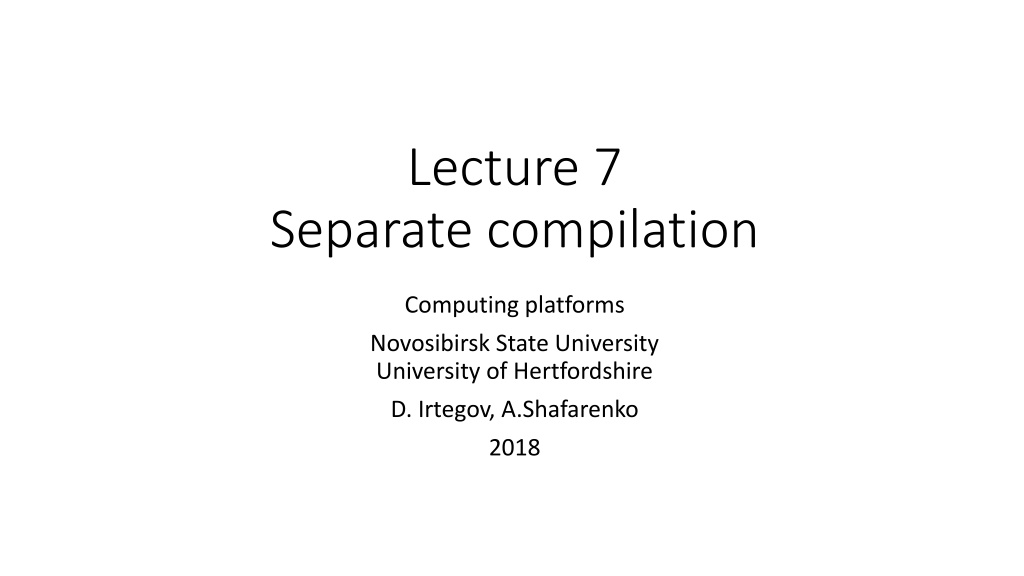

![Read⚡ebook✔[PDF] Linking the Space Shuttle and Space Stations: Early Docking Te](/thumb/21519/read-ebook-pdf-linking-the-space-shuttle-and-space-stations-early-docking-te.jpg)







